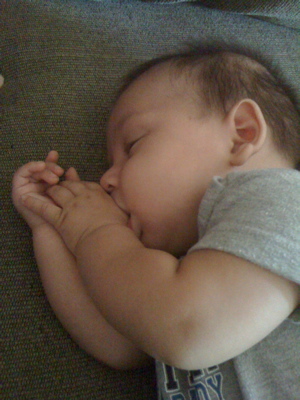What To Pray When Your Baby Isn’t Calming Down
 We have all been there before – you have done everything you can possibly think of and your baby is still crying. They have a clean diaper, they have been fed, burped, they aren’t sleepy, have clean clothes, temperature is right, they don’t have a fever, they aren’t constipated, the room is quiet, being held in their favorite position, they are healthy as far you know, and yet they are still crying. I would like to suggest another tool for your tool belt – prayer.
We have all been there before – you have done everything you can possibly think of and your baby is still crying. They have a clean diaper, they have been fed, burped, they aren’t sleepy, have clean clothes, temperature is right, they don’t have a fever, they aren’t constipated, the room is quiet, being held in their favorite position, they are healthy as far you know, and yet they are still crying. I would like to suggest another tool for your tool belt – prayer.
In the 5 months of my son’s life there have been times when Roman will cry uncontrollably. I can tell it is a different cry than when he is hungry or sleepy. It’s heartbreaking and nerve racking at the same time. So when my son is in this mood all I can think to do is pray. I also feel like he picks up on my stress level. If I am calm, then he will be more likely to calm down. So first I calm myself. Then I hold him in a quiet room in a comfortable position and I pray to God.
Here are some of the things I have prayed.
- I pray against any fear that he may have. Sometimes I think he becomes afraid and that is why he is crying. I don’t know why this prayer works, but it does. I actually say out loud, “I pray against a spirit of fear.” And then reassure my son that he has nothing to fear, that we aren’t going to leave him and I will always be with him.
- I pray for peace. I pray that his little body will have peace. I say the words, “peace and relax” in a soothing voice over and over. Even saying the words to myself, gives me peace.
- I pray for healing. Sometimes I think he may not be feeling well and I have no way of knowing what is bothering him. So I pray a general prayer asking God to heal whatever is ailing my son.
- I ask the Holy Spirit to comfort my son. In the Bible the Holy Spirit is called the Great Comforter. I believe that the Holy Spirit can comfort my baby in a way that I can not spiritually, so I ask for his help.
- I pray that my son would know how much he is loved. His father and I love him a lot, so do family and friends, and his Creator. I believe that babies find great comfort and peace when they feel loved and when they are told they are loved.
These five ideas for prayer aren’t new, but they are a good reminder to pray when your baby is flipping out. Now what to pray when a toddler is flipping out and throwing a tantrum is a whole other set of prayers! LOL.
Do you pray for your baby when he or she is crying? What do you pray for?
Share the fun: Email + Del.icio.us + Digg + Technorati







